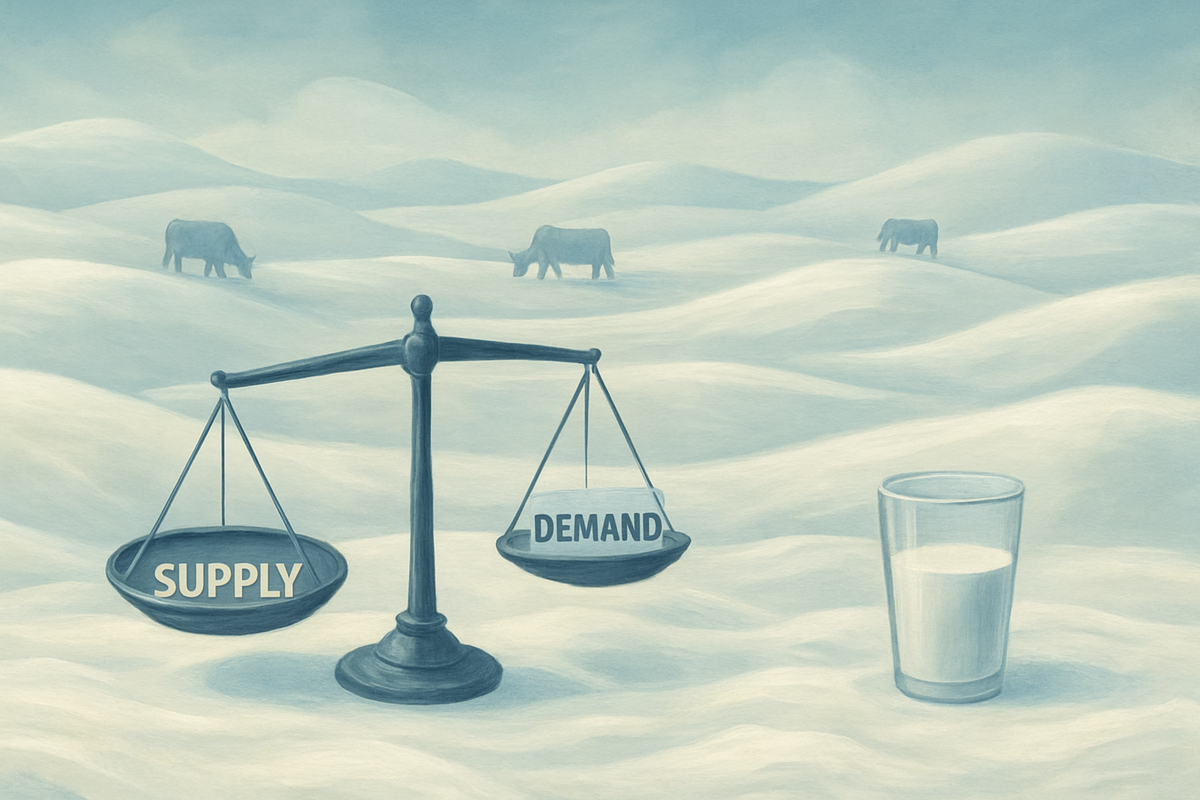
The global dairy market is currently navigating a period of significant imbalance, with a robust surge in supply threatening to overwhelm sustained, albeit not sufficiently strong, global demand. This dynamic is placing considerable downward pressure on dairy commodity prices worldwide, prompting concerns among major industry players, most notably New Zealand's dairy giant, Fonterra Co-operative Group Limited (NZX: FSF), which is facing mounting pressure to revise its farmgate milk price forecasts downwards for the current 2025/26 season.
As of November 2025, the market sentiment is decidedly bearish, driven by an expanding global milk supply that is outpacing consumption. While long-term demand growth remains positive, the immediate glut in supply has led to consecutive declines in Global Dairy Trade (GDT) auction prices, signaling a challenging period ahead for dairy farmers and processors globally. The implications extend beyond pricing, touching upon profitability, strategic decisions, and the competitive landscape for dairy producers.
A Deluge of Milk: Factors Behind the Supply Surge and Stable Demand
The current oversupply in the global dairy sector is a culmination of several interconnected factors. Improved farmgate prices experienced in the latter half of 2024, coupled with remarkably affordable feed costs, have significantly bolstered farmer margins in key export regions like Europe and New Zealand. This economic incentive has encouraged dairy farmers to ramp up production. Furthermore, supportive weather conditions across major producing areas, including parts of Europe and the United States, have contributed to healthier herds and increased milk yields. New Zealand, for instance, is tracking milk production almost 3% ahead of the last season.
Beyond these environmental and economic tailwinds, the dairy sector has also witnessed enhanced production efficiency, particularly in milk solids output. While total milk production in the US saw a slight decline in early 2025, milk solids production actually increased due to higher butterfat and protein tests. Herd expansion in certain regions, such as the addition of 197,000 cows in the US over 14 months, and a slight increase in New Zealand's herd size, further contribute to the supply influx. The commissioning of a record amount of new cheese processing capacity in late 2024 and into 2025, especially in the US, has also stimulated demand for raw milk, encouraging farmers to expand.
Despite this surge in supply, global dairy demand remains generally stable, underpinned by consistent drivers. Global population growth and an expected increase in per capita milk consumption (projected to reach 127 kg per person by 2025) continue to drive overall demand. Emerging markets, particularly in Asia (Southeast Asia and China) and Africa, are experiencing rising dairy consumption due to urbanization and increased nutritional awareness. The growing popularity of health-conscious and functional dairy products, such as lactose-free milk and high-protein yogurts, along with explosive growth in the foodservice sector (especially in China), further supports demand. However, this sustained demand is simply not robust enough to absorb the current "ample supplies of milk," leading to the prevailing market imbalance.
Fonterra at a Crossroads: Winners, Losers, and Market Adjustments
The current supply-demand dynamics are creating a complex landscape of potential winners and losers within the dairy industry. Dairy farmers globally, particularly those reliant on export markets, face the immediate prospect of reduced payouts. For Fonterra (NZX: FSF) farmers, the expectation is a downward revision of the cooperative's farmgate milk price forecast from the previously indicated $10 per kilogram of milk solids (kgMS) for the 2025/26 season, with analysts now anticipating a range in the mid-to-high $9/kgMS. While still a healthy payout historically, it represents a significant drop from the $10.16/kgMS paid for the 2024/25 season. This pressure on farmgate prices could squeeze farmer margins, especially for those with higher operational costs.
Major dairy processors and exporters, like Fonterra, are directly impacted by declining commodity prices, which can affect their revenue and profitability in their ingredients divisions. However, companies with a strong focus on value-added products, diversified portfolios, or robust domestic markets might be more resilient. For instance, Fonterra's strategic pivot to focus on its high-performing Ingredients and Foodservice businesses, alongside the recent sale of its global consumer business (excluding Greater China) to Lactalis (EPA: LACT), positions it to potentially mitigate some of the raw commodity price volatility. Other global players such as Saputo (TSX: SAP), Lactalis, and Dairy Farmers of America will also be navigating these market conditions, with their individual exposure to commodity markets and their product mix determining their resilience. Consumers, on the other hand, might see some relief in dairy product prices, although this often takes time to filter through the supply chain.
Fonterra is also grappling with intensified domestic competition in New Zealand, particularly in the crucial Waikato region. Independent processors like Open Country Dairy, Tatua, and Olam Food Ingredients are aggressively competing for milk supply, with some offering premiums above Fonterra's guaranteed price. This competition has seen Fonterra's share of the New Zealand milk pool shrink to 77.8% from 78.1% the previous year, despite the cooperative reporting significant profits and a record payout for the last season. This trend underscores the challenges even market leaders face in an environment of abundant supply and fierce competition for raw materials.
Broader Implications and Historical Parallels
The current dairy market situation is not an isolated event but rather fits into broader industry trends of cyclical commodity markets. Periods of high prices often incentivize increased production, which eventually leads to oversupply and subsequent price corrections. This cycle is exacerbated by the relatively long lead times in dairy farming, where decisions to increase herd sizes or build new processing plants take years to yield full impact, often coinciding with shifts in demand. The current scenario echoes past periods of dairy gluts, where strong production from key regions like the EU and New Zealand outpaced global import demand, leading to depressed prices.
The ripple effects of sustained low dairy prices can be significant. For dairy-exporting nations, it can impact trade balances and rural economies. Governments might face calls for support measures for struggling farmers. Regulatory bodies could also scrutinize market practices, particularly if competition for milk supply becomes overly aggressive. On the positive side, lower input costs for food manufacturers using dairy ingredients could lead to more competitive pricing for their end products, potentially boosting demand in the long run. The strategic divestment by Fonterra highlights a broader industry trend towards specialization and focusing on higher-margin segments, as companies seek to insulate themselves from the volatility of raw commodity markets.
Geopolitical tensions and shipping costs remain watchpoints, as they can disrupt supply chains and influence trade flows, adding another layer of complexity to the market. While the immediate outlook is challenging, some long-term analyses suggest a potential rebound in milk futures prices in late 2026 and 2027. This optimistic view is predicated on a limited supply of dairy cows and heifers due to the increasing practice of breeding for high-value beef calves, which could eventually constrain milk production growth.
Navigating the Future: Adaptations and Opportunities
Looking ahead, the global dairy market will require strategic pivots and adaptations from all stakeholders. In the short term, dairy producers will need to maintain sharp marketing strategies, focusing on cost management, particularly for feed, to navigate the volatile price environment. For processors like Fonterra, leveraging their strengths in ingredients and foodservice, as well as optimizing their operational efficiencies, will be crucial. The success of Fonterra's strategic shift and its ability to grow its retained Greater China consumer business will be key indicators of its long-term resilience.
In the long term, market opportunities may emerge from continued growth in emerging markets and the increasing consumer demand for diversified, value-added dairy products. Innovation in product development, focusing on health, convenience, and sustainability, will be vital for capturing market share and commanding premium prices. Companies that can adapt to changing consumer preferences and effectively manage their supply chains will be best positioned for success. Potential scenarios range from a prolonged period of low prices if supply continues to outpace even long-term demand growth, to a gradual rebalancing as production eventually adjusts and demand strengthens, potentially supported by population growth and economic recovery.
The industry may also see further consolidation or strategic partnerships as companies seek economies of scale or access to new markets and technologies. Investment in sustainable farming practices and carbon reduction initiatives could become increasingly important, not only for regulatory compliance but also as a differentiator for environmentally conscious consumers. The market will undoubtedly continue to evolve, presenting both challenges and opportunities for those agile enough to adapt.
Wrap-Up: A Market in Flux
The global dairy market is currently in a state of flux, characterized by a significant oversupply that is challenging the stability of demand and exerting downward pressure on prices. The immediate consequence is the anticipated revision of milk price forecasts by major players like Fonterra, impacting farmer payouts and the profitability of processors. While the factors contributing to the supply surge are clear – improved farmgate prices, affordable feed, and favorable weather – the challenge lies in rebalancing the market.
Moving forward, the dairy industry will need to closely monitor global milk production trends, consumer spending patterns, and the effectiveness of strategic shifts by major companies. Investors should watch for Fonterra's updated milk price forecasts, the performance of its Ingredients and Foodservice divisions, and its success in growing its Greater China consumer business. The competitive landscape in New Zealand will also be a key indicator of the health of the raw milk market. Ultimately, the ability of dairy producers and processors to manage costs, innovate, and adapt to evolving market dynamics will determine their success in this challenging environment.
This content is intended for informational purposes only and is not financial advice






